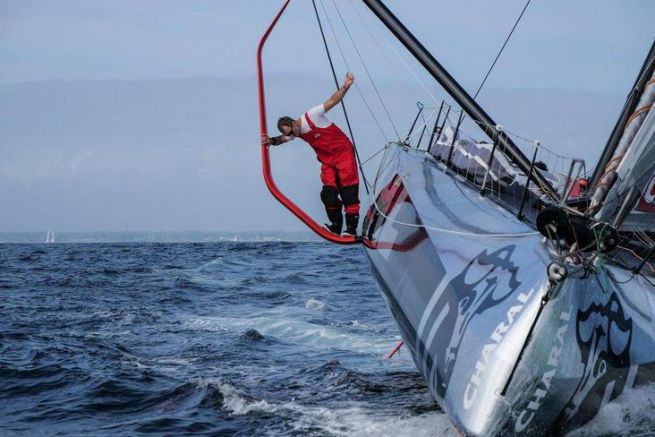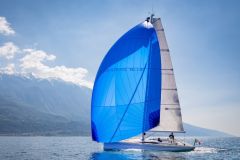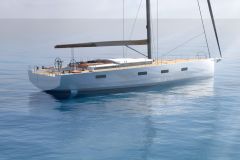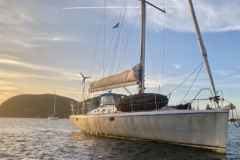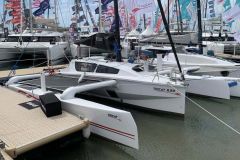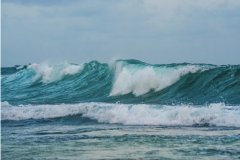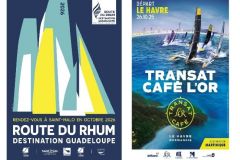Until his 13th birthday, Jérémie Beyou was a dinghy sailor, before moving to Moth Europe until he was 17/18. He then went on to sail in a habitable boat and took part in his first Solitaire du Figaro in 1997. "I won this race three times."
After a long period in ORMA multihull with Pascal Bidégorry, Jérémie discovered IMOCA in 2003 by participating in the Transat Jacques Vabre 2003. " Since then, I've been alternating between Le Figaro and IMOCA, taking part in the Vendée Globe, the Transat Jacques Vabre..."
A technical sailor, but a sailor before tout?!
Jérémie seems inaccessible and unshakeable, releasing the image of this ultra-technical and hardworking guy.
"I have this image of the guy passing through in force. Of course, it is never taken for granted. All single-handed victories are never about fingers in the nose. You always have to fight to win the extra small meter. I've been doing this for a long time and I take great pleasure in going to sea and going on these machines that are fabulous. We manage the development of performance, maintenance... We are discoverers on these flying monohulls."
But the sea is not only a means of exercising one's profession, it is also one's universe.
"I take great pleasure in continuing to sail and compete. If it wasn't, honestly, I wouldn't be here. It takes a lot of motivation to do what you do and it all comes down to the pleasure you take. I like to be on the water on any form of support. I kite, surf, catamaran, Finn, Moth... My universe is the sea and the coast. I wouldn't be able to do anything else."

The precursor of flying monohulls
Since August 2018, he has been sailing on the IMOCA Charal the first of the "new generation foilers." Unlike other IMOCAs with foils, these new boats have been "drawn around their foils and at the new foilers' gauge." By new gauge, he talks about the validation of rake settings on the foils, authorised since the 2016 Vendée Globe.
This VPLP plan built at CDK "VPLP goes much faster with big foils."
A more stable and balanced boat
While the start was technically difficult for Charal, the boat showed its full potential one year later in the races of the 2019 season. The technical team has worked hard on balance and speed stability.
"We've been working on the sails and trim in all wind conditions. The two rudders, the swivelling keel (90° from one side to the other), were changed. We have optimized the dynamic settings, but also the foils - which can be lifted/lowered, the rotating mast, or the ballasts..."
The team worked for hours on the consistency of all these settings with the objective of moving fast all the time. The goal is to increase versatility and reduce "holes" in the performance polar fleeces.
The boat's dynamic balance has also been reworked, particularly in terms of ballast volume, but also in terms of the keel bulb, which has been completely renewed. "It changes the quest, but also the stability."

© G. Lebec
More optimizations to come
This winter, Charal will start work on a new optimization project. In particular, it will receive a new generation of foils. "We have launched the production of a new pair of foils that we will receive this winter. We will install them before the launch scheduled for March 2020."
To design this new pair of foils, the technical team did a lot of work on a dynamic simulator at VPLP. The evolution of numerical models is constantly evolving and has enabled the design of these new appendices, which promise a significant increase in VPPs.
"We started working on this boat in early 2017. Two years after launching, the experience gained in the implementation of composites on these complex parts has made it possible to increase the load resistance of the foils and to optimize the profiles".
Other workstations will allow Charal to improve, such as sails or deck fittings.
A complex development program
A year after the launch, Jeremie has much better control over his boat. Indeed, the beginnings were difficult, because they had to clear a technological universe that was still unknown not long ago.
"These are complex boats on which we have no electronic servoing or foil automation systems. We are able to make exceptional speed peaks. So our job is to increase our average speed with versatile and high-performance foils. It's a compromise setting to compensate for the lack of constant adjustment during our solo sailing."
The team and the skipper worked hard on Charal, meeting the schedule they had set for themselves. "We knew we were going to discover a lot about this boat. Between our mastery on the eve of the 2018 Route du Rhum and today's, it's day and night."

© G. Lebec
The acquisition of experience
To make the IMOCA black and silver more reliable, the team sailed a lot, to experience various conditions. "We are based on the principle that we learn every time we sail. The boat was tested in harsh conditions, particularly in spring 2018, but also in winter conditions after the Route du Rhum 2018. These tests confirmed the structural reliability."
The team was also able to test the flight and validate this new capacity, which was only recorded on the paper at the start. "We spent more time on construction than the new boats that were able to save a little time when seeing the final result."
Because if Charal came out a year before the others, it's because Jeremie no longer had a boat and wanted to respect a certain timing. "Before each of my Vendée Globe races, I regretted a too hasty preparation. I wanted something different for 2020."
Launching the boat in 2018 offered the team the opportunity to analyse the IMOCA and prepare a version 2 for 2020. Today, Charal is reliable and no longer encounters the technical problems inherent in all new boats.
"We have a good boat and undoubtedly the best in terms of potential and reliability at the start of the next Vendée Globe. That's why I don't know if our schedule was the best, I don't know. It is certain that the teams that recently launched will have a shorter discovery period than ours, because we have opened the way for these flying boats."
Nevertheless, Jeremiah remains rational and knows that Charal will not be without competition. We expect a lot from Alex Thomson's new VPLP plan or Charlie Dalin's Verdier Apivia plan.
The forces involved
To design Charal, the team largely based itself on the weather statistics of a Vendée Globe and the objective to be achieved. "In the Vendée Globe, our objective is to be in the lead after the Saint Helena bypass, at the exit of the South Atlantic."
It is with this ambition that the Charal Sailing Team has built a boat with a tight enough hull and foils to sail upwind correctly. "Our vision is to be able to take off very early, from the reaching medium. We have targeted foils that push hard by flying the entire boat. We tried to reduce the hull drag as much as possible in these take-off speeds. So it's a boat that's pretty round on the transom." As a result, the drag is limited compared to competitors.

Victory objective, but fierce competition
It is ready for Jeremie to start the Transat Jacques Vabre 2019. Boosted by his recent victories at the Azimut Challenge and Rolex Fastnet, he intends to maintain his status.
"We want to keep this place. On the Azimuth Challenge, we maintained the lead throughout the race. We sailed cleanly. On the Rolex, it was less accomplished even if we won. We don't get the wrong idea, it's gonna be hard. We avoid getting carried away, but the goal is still victory."
However, it will have to face new competitors, absent from previous races. "Our boat is reliable and in our hands. We are ready and we think we have assets and have proven that we can be leaders. Now we'll have to deal with the others. Apivia has great potential, with a great crew. We are suspicious of them, but so is Alex (Thomson). On Arkea, it will continue to improve and he will not stay on the results he did on the Challenge. PRB is very strong, consistent and constant."
As in these two previous races, he will be accompanied by Christopher Pratt. The two sailors have established an attacking strategy that allows them to widen the gap with the competitors. Jeremie and Christopher have a "long story" and have already raced together in the Figaro, the Tour de France à la Voile or the Transat Jacques Vabre.
"Christopher tried to set up a Vendée Globe 2020 project that didn't succeed. So we asked him to join us. I had already participated in a Jacques Vabre that went well with him."
Used to "home" and working regularly with the team, Christopher Pratt quickly established himself as the ideal co-skipper. Having had his own IMOCA DCNS project and having collaborated with Armel le Cléac'h or Jérémie Beyou on Maître Coq, Christopher is at ease on his own.
"He has all the qualities of a skipper and knows how to sail the boat alone. We're having fun too. We speak the same language, we have the same way of doing things. We know that our boats are complex and it's easier not to complicate your life with a bad choice of coskipper."
